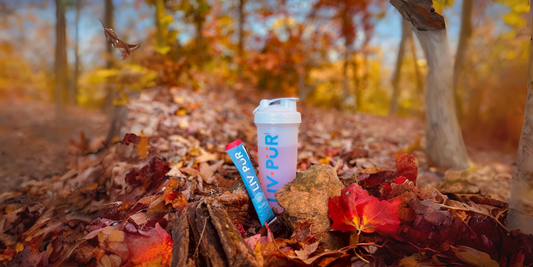Currently, the World Health Organization recommends no more than 6 teaspoons of added sugar per day. Then how come Americans are consuming on average 22 teaspoons of added sugar per day? And that’s not the sugar from healthy fruits like apples and berries. That’s just the refined white powder!
So, it’s probably time to think about how to cut down on your sugar intake… if not quit refined sugar altogether. It’s not an easy process; you could even experience sugar withdrawal symptoms like changes in mood, anxiety, sleep troubles, fatigue, dizziness, etc. But we’re here to give you the rundown on how to effectively quit sugar as easily as possible.
How to quit sugar in 8 simple steps
Congrats on making the big decision to cut refined sugar from your diet! It may be a slow and tough process, but just wait until you feel how your body functions without all that added sugar!
1. Don’t quit cold turkey
Some will advise you to stop eating sugar all at once — not us! In order to make sustainable health changes, it’s best to implement slow but steady adjustments. If you consume a lot of added sugar, stopping all at once will produce a lot of unwanted withdrawal symptoms and leave you feeling extra discouraged. Slowly wean off of sugar, starting with the easiest to the toughest items to eliminate. Maybe try skipping sugar in your coffee first. Then work your way onto deserts. Just don’t do it all at once!
2. Avoid blood sugar crashes
Low blood sugar equals some serious sugar cravings. Because of that, it’s important to help stabilize blood sugar crashes by eating regular meals. When you skip a meal, your blood sugar drops, causing your body to crave sugar in an effort to raise blood sugar levels. A quick boost in sugar prompts a rush of insulin to the body, which drops your blood sugar low once again. It’s a vicious cycle.
3. Stay hydrated
Around here, we’re big fans of hydration. It’s essential to help keep your body and its organs functioning properly. In fact, hydration even plays a role in your hunger levels as well as cravings. Dehydration can prevent your body from properly metabolizing glycogen (the converted form of glucose) for energy. Without enough glycogen, your body craves sugar to get the energy it needs.
So when you’re craving sugar (and ideally way before), reach for a glass of water. For added hydration benefits, use a packet of LivPür Hydrate with your water.* Why?
Hydration isn’t just about drinking water; it’s about replenishing your cells with essential nutrients and maintaining balance of all the important electrolytes.
You don’t just need to drink more water. You need to drink smarter!
*LivPür Hydrate does contain a small amount of dextrose, the most absorbable form of sugar. It’s naturally occurring and found in our own bodies. Not all sugar is bad — this one helps you absorb the nutrients found in LivPür Hydrate into your bloodstream.
4. Prioritize sleep
If you’ve ever felt hungrier or had intense cravings for high-calorie foods the day after a rough night of sleep, you’re not alone. In fact, research shows that sleep deprivation affects food cravings. When you don’t get sufficient sleep, your hormones suffer. Ghrelin, the hunger hormone, increases. Leptin, the appetite-suppressing hormone, decreases. And cortisol, your stress hormone, may even increase, causing a rise in your cravings and appetite. Getting those seven to nine hours of sleep at night may help keep stress at bay, improve your productivity and concentration, AND reduce sugar cravings.
5. Exercise!
Research shows that short workout sessions can help reduce sugar cravings, even if it’s just a 15-minute brisk walk. So if you needed one more reason to get up and get moving, here’s one! Exercising, including a simple walk, also helps lower cortisol (or stress) levels that can contribute to your desire for sugar. Basically, exercising is a great idea — cutting sugar or not.
6. Reframe your thinking
We often see sugar as a treat, so without it, it feels like punishment. Whenever you’re giving up a food, it’s important to focus on what you still can have instead of what you can’t. Otherwise you may grow resentful and frustrated. Try internal dialogue like, “I’m avoiding sugar to boost my health and wellbeing. I don’t want to put that into my body, but I’m going to have an apple with creamy almond butter instead!”
7. Fill up on the good stuff
Skip all of the refined carbs and nutrient-void junk foods! Loading your meals up with healthy fats and lean proteins will not only help keep your blood sugar balanced, but it’ll also keep you feeling full! Both fats (like nuts, avocados, and olive oil) and protein (chicken, turkey, eggs, and legumes) contribute to satiety. When you’re full, you’re less likely to feel — or give into — those pesky sugar cravings.
8. Find healthier alternatives
Quitting sugar doesn’t have to mean giving up sweet flavors. Fruit is a part of a healthy, well-balanced diet. Natural sweeteners like stevia can be too! Stevia is plant-derived with almost no carbs or calories. It’s the sweetener we use here at LivPür for Plant Protein, Recovery, and Energy. Stevia sweetens so well that some even say LivPür tastes like candy!
So if you’re struggling to kick sugar, try LivPür in place of other energy drinks, sports drinks, juices, or sodas. You’ll curb your sweet tooth and reap tremendous health benefits at the same time. It’s a win-win.




